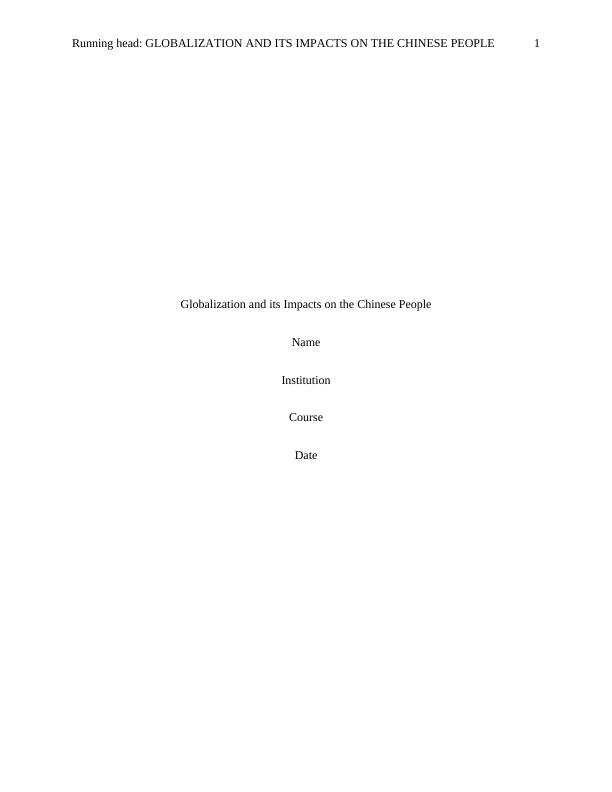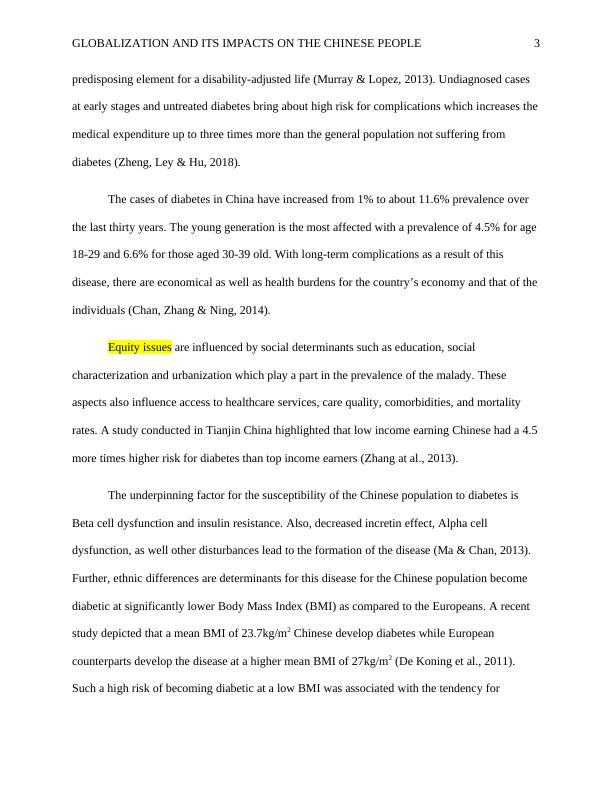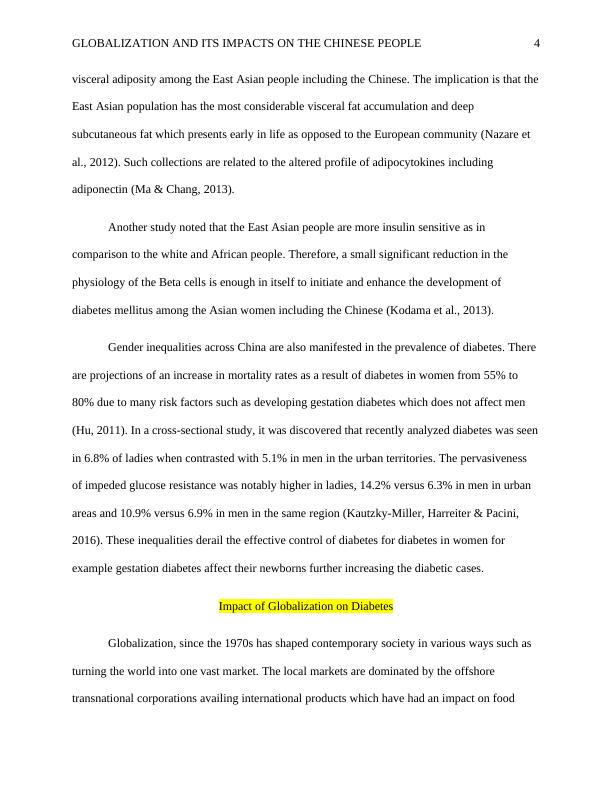Globalization and its Impacts on the Chinese People
Added on 2022-11-29
13 Pages3970 Words465 Views
Running head: GLOBALIZATION AND ITS IMPACTS ON THE CHINESE PEOPLE 1
Globalization and its Impacts on the Chinese People
Name
Institution
Course
Date
Globalization and its Impacts on the Chinese People
Name
Institution
Course
Date

GLOBALIZATION AND ITS IMPACTS ON THE CHINESE PEOPLE 2
Globalization and its Impacts on the Chinese People
Introduction
The contemporary society faces a multiple health challenges. The World Health
Organization (WHO) has prioritized these issues into ten top most health threats demanding
immediate attention to counter its already felt impacts. Noncommunicable diseases, for example,
cancer and diabetes account for the death of about 41 million persons worldwide making them be
included in the top ten worldwide health issues. Diabetic cases are expected to rise to 438 million
people with its financial burden increasing to 490 billion dollars form 376 billion dollars by 2030
(World Health Organization, 2014).
About 0.6% of the global diabetic cases are found in the Asian continent, and China is
responsible for these high proportions. Rapid economic growth, urbanization, and transitions in
nutritional values which are fueled by globalization are attributed to the increased incidences of
diabetes among the Chinese people (Zheng, Ley & Hu, 2018). In this article, the effects of
globalization on diabetes among the Chinese population and recommendations for checking this
public health issue will be discussed.
Public Health Significance and Equity Issues of Diabetes
One among eleven adults (20-79 years) across the globe suffer from type 2 diabetes
mellitus which responsible for over 90% of all diabetic cases. According to a study on the global
burden of diseases, diabetes was marked as the ninth influential cause of decreased life
expectancy (Abubakar, Tillmann & Banerjee, 2015). Besides its high mortality rate (6.8%),
diabetes has led to increased incidences of disability particularly among persons aged 15-69
years (Herricks et al., 2017). A high fasting level of glucose is the dominant worldwide
Globalization and its Impacts on the Chinese People
Introduction
The contemporary society faces a multiple health challenges. The World Health
Organization (WHO) has prioritized these issues into ten top most health threats demanding
immediate attention to counter its already felt impacts. Noncommunicable diseases, for example,
cancer and diabetes account for the death of about 41 million persons worldwide making them be
included in the top ten worldwide health issues. Diabetic cases are expected to rise to 438 million
people with its financial burden increasing to 490 billion dollars form 376 billion dollars by 2030
(World Health Organization, 2014).
About 0.6% of the global diabetic cases are found in the Asian continent, and China is
responsible for these high proportions. Rapid economic growth, urbanization, and transitions in
nutritional values which are fueled by globalization are attributed to the increased incidences of
diabetes among the Chinese people (Zheng, Ley & Hu, 2018). In this article, the effects of
globalization on diabetes among the Chinese population and recommendations for checking this
public health issue will be discussed.
Public Health Significance and Equity Issues of Diabetes
One among eleven adults (20-79 years) across the globe suffer from type 2 diabetes
mellitus which responsible for over 90% of all diabetic cases. According to a study on the global
burden of diseases, diabetes was marked as the ninth influential cause of decreased life
expectancy (Abubakar, Tillmann & Banerjee, 2015). Besides its high mortality rate (6.8%),
diabetes has led to increased incidences of disability particularly among persons aged 15-69
years (Herricks et al., 2017). A high fasting level of glucose is the dominant worldwide

GLOBALIZATION AND ITS IMPACTS ON THE CHINESE PEOPLE 3
predisposing element for a disability-adjusted life (Murray & Lopez, 2013). Undiagnosed cases
at early stages and untreated diabetes bring about high risk for complications which increases the
medical expenditure up to three times more than the general population not suffering from
diabetes (Zheng, Ley & Hu, 2018).
The cases of diabetes in China have increased from 1% to about 11.6% prevalence over
the last thirty years. The young generation is the most affected with a prevalence of 4.5% for age
18-29 and 6.6% for those aged 30-39 old. With long-term complications as a result of this
disease, there are economical as well as health burdens for the country’s economy and that of the
individuals (Chan, Zhang & Ning, 2014).
Equity issues are influenced by social determinants such as education, social
characterization and urbanization which play a part in the prevalence of the malady. These
aspects also influence access to healthcare services, care quality, comorbidities, and mortality
rates. A study conducted in Tianjin China highlighted that low income earning Chinese had a 4.5
more times higher risk for diabetes than top income earners (Zhang at al., 2013).
The underpinning factor for the susceptibility of the Chinese population to diabetes is
Beta cell dysfunction and insulin resistance. Also, decreased incretin effect, Alpha cell
dysfunction, as well other disturbances lead to the formation of the disease (Ma & Chan, 2013).
Further, ethnic differences are determinants for this disease for the Chinese population become
diabetic at significantly lower Body Mass Index (BMI) as compared to the Europeans. A recent
study depicted that a mean BMI of 23.7kg/m2 Chinese develop diabetes while European
counterparts develop the disease at a higher mean BMI of 27kg/m2 (De Koning et al., 2011).
Such a high risk of becoming diabetic at a low BMI was associated with the tendency for
predisposing element for a disability-adjusted life (Murray & Lopez, 2013). Undiagnosed cases
at early stages and untreated diabetes bring about high risk for complications which increases the
medical expenditure up to three times more than the general population not suffering from
diabetes (Zheng, Ley & Hu, 2018).
The cases of diabetes in China have increased from 1% to about 11.6% prevalence over
the last thirty years. The young generation is the most affected with a prevalence of 4.5% for age
18-29 and 6.6% for those aged 30-39 old. With long-term complications as a result of this
disease, there are economical as well as health burdens for the country’s economy and that of the
individuals (Chan, Zhang & Ning, 2014).
Equity issues are influenced by social determinants such as education, social
characterization and urbanization which play a part in the prevalence of the malady. These
aspects also influence access to healthcare services, care quality, comorbidities, and mortality
rates. A study conducted in Tianjin China highlighted that low income earning Chinese had a 4.5
more times higher risk for diabetes than top income earners (Zhang at al., 2013).
The underpinning factor for the susceptibility of the Chinese population to diabetes is
Beta cell dysfunction and insulin resistance. Also, decreased incretin effect, Alpha cell
dysfunction, as well other disturbances lead to the formation of the disease (Ma & Chan, 2013).
Further, ethnic differences are determinants for this disease for the Chinese population become
diabetic at significantly lower Body Mass Index (BMI) as compared to the Europeans. A recent
study depicted that a mean BMI of 23.7kg/m2 Chinese develop diabetes while European
counterparts develop the disease at a higher mean BMI of 27kg/m2 (De Koning et al., 2011).
Such a high risk of becoming diabetic at a low BMI was associated with the tendency for

GLOBALIZATION AND ITS IMPACTS ON THE CHINESE PEOPLE 4
visceral adiposity among the East Asian people including the Chinese. The implication is that the
East Asian population has the most considerable visceral fat accumulation and deep
subcutaneous fat which presents early in life as opposed to the European community (Nazare et
al., 2012). Such collections are related to the altered profile of adipocytokines including
adiponectin (Ma & Chang, 2013).
Another study noted that the East Asian people are more insulin sensitive as in
comparison to the white and African people. Therefore, a small significant reduction in the
physiology of the Beta cells is enough in itself to initiate and enhance the development of
diabetes mellitus among the Asian women including the Chinese (Kodama et al., 2013).
Gender inequalities across China are also manifested in the prevalence of diabetes. There
are projections of an increase in mortality rates as a result of diabetes in women from 55% to
80% due to many risk factors such as developing gestation diabetes which does not affect men
(Hu, 2011). In a cross-sectional study, it was discovered that recently analyzed diabetes was seen
in 6.8% of ladies when contrasted with 5.1% in men in the urban territories. The pervasiveness
of impeded glucose resistance was notably higher in ladies, 14.2% versus 6.3% in men in urban
areas and 10.9% versus 6.9% in men in the same region (Kautzky-Miller, Harreiter & Pacini,
2016). These inequalities derail the effective control of diabetes for diabetes in women for
example gestation diabetes affect their newborns further increasing the diabetic cases.
Impact of Globalization on Diabetes
Globalization, since the 1970s has shaped contemporary society in various ways such as
turning the world into one vast market. The local markets are dominated by the offshore
transnational corporations availing international products which have had an impact on food
visceral adiposity among the East Asian people including the Chinese. The implication is that the
East Asian population has the most considerable visceral fat accumulation and deep
subcutaneous fat which presents early in life as opposed to the European community (Nazare et
al., 2012). Such collections are related to the altered profile of adipocytokines including
adiponectin (Ma & Chang, 2013).
Another study noted that the East Asian people are more insulin sensitive as in
comparison to the white and African people. Therefore, a small significant reduction in the
physiology of the Beta cells is enough in itself to initiate and enhance the development of
diabetes mellitus among the Asian women including the Chinese (Kodama et al., 2013).
Gender inequalities across China are also manifested in the prevalence of diabetes. There
are projections of an increase in mortality rates as a result of diabetes in women from 55% to
80% due to many risk factors such as developing gestation diabetes which does not affect men
(Hu, 2011). In a cross-sectional study, it was discovered that recently analyzed diabetes was seen
in 6.8% of ladies when contrasted with 5.1% in men in the urban territories. The pervasiveness
of impeded glucose resistance was notably higher in ladies, 14.2% versus 6.3% in men in urban
areas and 10.9% versus 6.9% in men in the same region (Kautzky-Miller, Harreiter & Pacini,
2016). These inequalities derail the effective control of diabetes for diabetes in women for
example gestation diabetes affect their newborns further increasing the diabetic cases.
Impact of Globalization on Diabetes
Globalization, since the 1970s has shaped contemporary society in various ways such as
turning the world into one vast market. The local markets are dominated by the offshore
transnational corporations availing international products which have had an impact on food

End of preview
Want to access all the pages? Upload your documents or become a member.
Related Documents
Type 2 Diabetes Among Aboriginal Peoplelg...
|11
|3097
|80
Relationship between the Method of Education and Self-Care Activities among Newly Diagnosed Diabetes Patientslg...
|18
|4861
|454
Diabetes Needs Assessment in a Community with Identified Areaslg...
|11
|3224
|207
Poor Nutrition in Australia: A Public Health Concernlg...
|14
|4337
|478
The Epidemiology of Cardiovascular Disease in Type 2 Diabeteslg...
|10
|2718
|61
Indigenous Health and Wellbeing Essay 2022lg...
|9
|2222
|19
